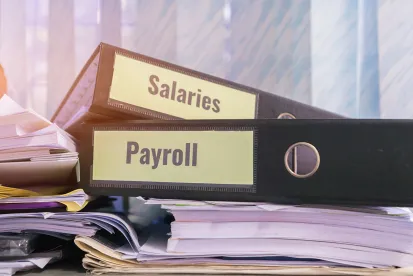Some questions answered, many still remain
On April 1, 2020, the U.S. Department of Labor (DOL) released new regulations (29 CFR Part 826), attempting to clarify certain provisions in the Families First Coronavirus Response Act (FFCRA). As we previously reported here, under the Emergency Paid Sick Leave Act provision of the FFCRA, certain public employers and private employers with fewer than 500 employees must provide up to eighty (80) hours of emergency paid sick leave (a prorated amount for part-time employees) (EPSL) if the employee is unable to work or telework because of one of these six qualifying reasons:
-
The employee is subject to a Federal, State, or local quarantine or isolation order related to COVID-19;
-
The employee has been advised by a health care provider to self-quarantine due to concerns related to COVID-19;
-
The employee is experiencing symptoms of COVID-19 and seeking medical diagnosis from a health care provider;
-
The employee is caring for an individual who is subject to a quarantine or isolation order or has been advised by a health care provider to self-quarantine due to concerns related to COVID-19;
-
The employee is caring for his or her son or daughter whose school or place of care has been closed for a period of time, whether by order of a State or local official or authority or at the decision of the individual school or place of care, or the child care provider of such son or daughter is unavailable, for reasons related to COVID-19; or
-
The employee has a substantially similar condition as specified by the Secretary of Health and Human Services, in consultation with the Secretary of the Treasury and the Secretary of Labor.
The DOL’s regulations – notable for the speed in which they were published, about a week after the FFCRA became law – help to explain the reasons for which EPSL may be taken with greater precision.
When is an employee eligible to use EPSL because he or she is “subject to a federal, state, or local COVID-19 quarantine or isolation order”?
The first issue that the regulations clarify is when an employee is subject to a Federal, State, or local quarantine or isolation order under the first qualifying reason. The answer is: Not as often as you might think.
Contrary to many commentators’ expectations when the FFCRA was enacted, the first qualifying reason pursuant to which employees’ may take EPSL does not apply when an employee is unable to work because his or her employer is subject to an order – even a quarantine order – shutting the business down or substantially curtailing its operations. According to § 826.20(a)(2), this reason for EPSL applies:
only if, but for being subject to the order, he or she [the employee] would be able to perform work that is otherwise allowed or permitted by his or her Employer, either at the Employee’s normal workplace or by Telework. An Employee Subject to a Quarantine or Isolation Order may not take Paid Sick Leave where the Employer does not have work for the Employee as a result of the order or other circumstances.
In other words, if the employer shuts down or furloughs some employees because their work is not deemed to be essential under applicable state or local health orders, the employee is not eligible to take EPSL for this reason. This does not mean that the employer is barred from extending paid leave to the employee, but the employer will not be eligible for a tax credit on the wages paid for that leave and it likely will not count against the employee’s 80-hour EPSL allotment.
The DOL offered a concrete example:
If the coffee shop closed due to its customers being required to stay at home, the reason for the cashier being unable to work would be because those customers were subject to the stay-at-home order, not because the cashier himself was subject to the order. Similarly, if the order forced the coffee shop to close, the reason for the cashier being unable to work would be because the coffee shop was subject to the order, not because the cashier himself was subject to the order.
The Department’s illustration works well when the employer and the employee are subject to the same health orders. However, many employers have employees who live in one state and work in another or who live in one city or county while working in another. For example, six counties in the San Francisco Bay Area issued more restrictive shelter-in-place orders on March 31. Under those orders, employees of non-essential businesses are not permitted to go to work. If their employer’s worksite is outside those counties and is permitted to operate under more permissive definitions of essential business under the statewide order, it would appear to be the case that the employee would be entitled to use EPSL based on the first reason because a quarantine order has not shuttered the employer or eliminated the employee’s work. It is only the local quarantine order applicable to the employee keeping the employee at home. This circumstance will hopefully be uncommon, but the possibility of contradictory state or local health orders underscores that employers will need to carefully assess individual circumstances before denying leave requests.
When has an employee been “advised by a health care provider to self-quarantine?”
The FFCRA also allows eligible employees to take EPSL when an employee is unable to work or telework because the employee has been “advised by a health care provider to self-quarantine” due to concerns related to COVID-19. The regulations clarify that an employee may take EPSL for this reason only if a health care provider (as defined in 29 CFR § 825.102) advises the employee to self-quarantine based on a belief that the employee:
- has COVID-19,
- may have COVID-19, or
- is particularly vulnerable to COVID-19.
In addition, following the advice of a health care provider to self-quarantine must prevent the employee from being able to work, either at the employee’s normal workplace or by telework. Under the regulations, employees who are self-quarantining are able to telework (and therefore are not permitted to take EPSL for this reason) if their employer has work for them to perform, their employer allows them to perform that work from the location where they are self-quarantining, and there are no extenuating circumstances that prevent them from performing the work (such as severe COVID-19 symptoms).
What constitutes “seeking medical diagnosis from a health care provider?”
The FFCRA also extends EPSL to employees who are unable to work or telework because they are experiencing symptoms of COVID-19 and “seeking a medical diagnosis.” According to the regulations, an employee may take EPSL on this basis if he or she is experiencing any of the symptoms of COVID-19 identified by the U.S. Centers for Disease Control and Prevention, including fever, dry cough, or shortness of breath. However, the EPSL taken for this third qualifying reason is limited to the period of time that the employee is unable to work because he or she is taking affirmative steps to obtain a medical diagnosis, such as making, waiting for, or attending an appointment for a test for COVID-19. Further, the employee may not take EPSL to self-quarantine without seeking a medical diagnosis. As with the previous qualifying reason, if the employee is able and allowed to telework during this period, the employee does not qualify to take EPSL under this third qualifying reason. If the employee tests positive for COVID-19, then he or she may be eligible for additional leave under the first or second qualifying reasons.
When does an employee qualify for EPSL while “caring for an individual?”
The fourth qualifying reason for paid sick leave applies where an employee is unable to work or telework because he or she is “caring for an individual” who depends on the employee to care for him or her, when the cared-for individual is either subject to a quarantine or isolation order or has been advised by a health care provider to self-quarantine. In this context, the term “individual” means an employee’s “immediate family member, a person who regularly resides in the Employee’s home, or a similar person with whom the Employee has a relationship that creates an expectation that the Employee would care for the person if he or she were quarantined or self-quarantined.” However, an employee may not take paid sick leave to take care of someone with whom the employee has no personal relationship. According to the regulations, an employee may not take EPSL for this reason unless the employee would otherwise be able to perform work for his or her employer (either at the employee’s normal workplace or by telework) but for the need to care for the individual. Accordingly, an employee caring for an individual may not take paid sick leave where the employer does not have work for the Employee to perform.
The regulations further clarify that an employee may only take EPSL in this circumstance if the need to care for the individual prevents the employee from being able to perform work for his or her employer, and the individual “depends on” the employee to care for him or her. Moreover, the individual being cared for must be subject to a Federal, State, or local quarantine or isolation order or have been advised by a health care provider to self-quarantine because of a belief that the individual:
- has COVID-19,
- may have COVID-19 due to known exposure or symptoms, or
- is particularly vulnerable to COVID-19.
How much do I pay employees on EPSL or EFMLA?
The FFCRA requires employers to pay employees at their regular rate of pay if the employee takes EPSL (1) based on a COVID-19 quarantine, (2) based on self-isolation advice from a health care provider, or (3) because they are experiencing COVID-19 symptoms and are seeking diagnosis for up to 80 hours, capped at $511 a day (or $5,110 in total). The Act also makes clear that employees (4) caring for a qualified individual under a COVID-19 quarantine or self-isolation advice from a health care provider or (5) caring for their own children due to a school or child care provider closing are entitled to up to 80 hours of sick leave paid at two-thirds their regular rate of pay, capped at $200 a day (or a total of $2,000). Under the public health emergency paid Family and Medical Leave Act expansion (EFMLA), employees who have a need to care for their children because of school or childcare closings or care provider unavailability are entitled to up to an additional 10 weeks of pay, at two-thirds their regular rate of pay, up to $200/day (or a total of $10,000).
Although many commentators’ assumption when the FFCRA passed was that this calculation was based on the employees’ hourly rate or salary in effect when EPSL/EFMLA is taken, the regulations now explain that employers must calculate employees’ “average regular rate” using a six-month look-back from the date on which leave begins.
-
The first step in this calculation is to determine the employee’s regular rate of pay for each full workweek over the six-month period ending on the date the employee starts to take leave. If the employee has worked fewer than six months, use the employee’s entire period of employment.
-
When calculating the weekly regular rate, employers must be cognizant that, under the Fair Labor Standards Act, the regular rate is calculated based on “all [non-overtime] remuneration for employment” except for eight statutory exclusions. This means, among other things, that non-discretionary bonuses and incentives must be included in determining the regular rate. For example, perfect attendance bonuses should be included in the regular rate, but a discretionary holiday bonus likely need not be included. Overtime premiums do not need to be included either, but extra base pay for overtime hours does count. (In other words, when you pay somebody 1.5x for overtime, you need to include the straight time value but not the .5 premium factor.) There are also special rules for tipped and commission-paid employees.
-
Once all of the applicable weekly regular rates have been calculated, the employer must average them. Although it would be simpler to add all of these weeks together and divide them by 26 (and that might be the formula for salaried employees without varying or weighted compensation), the DOL requires that employers then weight the regular rates based on the number of hours an employee worked over the six-month lookback period. To illustrate using a simple example:
In Week 1, Employee works 40 hours and is paid $1,000. The regular rate for week 1 is $25 ($1,000 ÷ 40 hours = $25/hour).
In Week 2, the employee works 45 hours and gets a non-discretionary bonus payment of $500, for total non-overtime remuneration of $1,625. The regular rate for week 2 is $36.11 [((45 hours x $25) + $500) ÷ 45 hours = $36.11].
If you used simple averaging of each week’s regular rate of pay, the average regular rate for those two weeks would be $30.56 (($36.11 + $25) ÷ 2). But using weighted averaging, you add the total earnings from both weeks and divide by the number of hours worked in those two weeks and instead get $30.88 (($1,000+$1,625) ÷ 85 hours). The same formula must instead be done over a 26-week period (rather than this simple two-week example) to determine the employee’s weighted non-overtime rate of pay. How important is that extra 32 cents? As far too many businesses know, those sorts of errors are exactly the fodder for numerous wage and hour class actions, which come with liquidated damages, civil money penalties, and the allure of attorneys’ fees.
Conclusion
Determining whether an employee qualifies for benefits under the FFCRA requires a complex, fact-intensive analysis, and employers should not make such conclusions in haste. Likewise, determining how much employees are entitled to be paid when exercising EPSL or EFMLA may be far more complicated than it seemed at first blush. Employers are strongly encouraged to consult their attorney when evaluating an employee’s FFCRA leave request to ensure they are properly weighing all necessary considerations and maximizing tax credit benefits.






 />i
/>i


